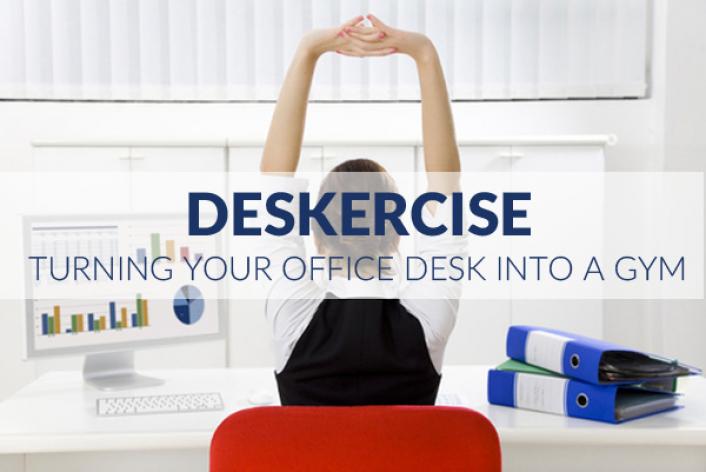
Due to the demands of modern life, more and more of our clients are in the office between 8am and 6pm, often with a lengthy commute at each end. Although it is still possible to make time for a fitness regime, many people struggle. To help combat this, we’ve started recommending a few desk exercises for our busiest clients. Desk exercise is a great way to combat our sedentary lifestyles, help beat the slouch and fit a bit of exercise into the day.
There are so many different exercises you can do at your desk, including mobility/stretching exercises, strengthening exercises and metabolic exercises to get the heart going. I’ve included a few of my top ones here to give you the ultimate deskercise workout. So, kick off the high heels, remove the tie and unbutton your top buttons, as we're about to get the blood flowing and warmed up!
Mobility and warm up - the clients who work at a desk often develop slumped over postures and complain of having pain or discomfort in at least one of the following areas: neck, lower back, shoulders and upper back/traps. The exercises in our mobility and warm up circult will help to release these tight muscles that develop as a result of sitting all day. They will help 'activate' our postural muscles and develop movement in the spin, neck and shoulder regions. These exercises are key for increasing mobility and keeping muscular-skeleto issues at bay.
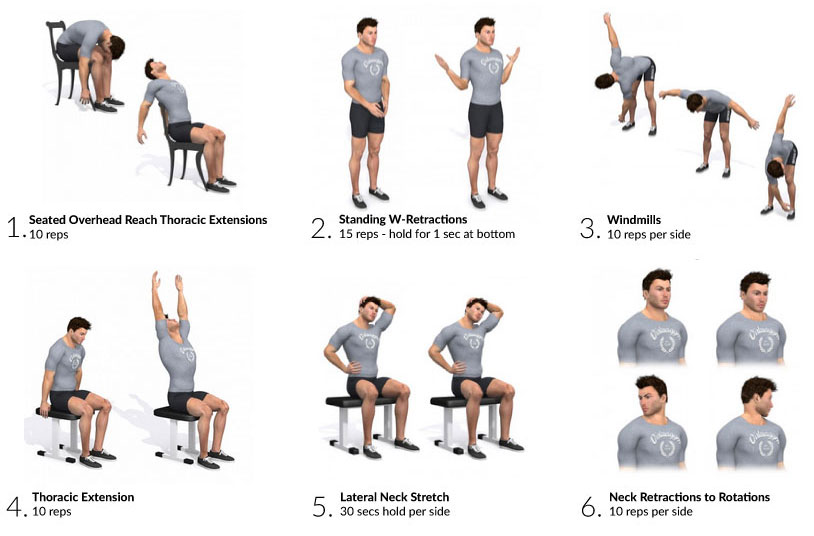
Top Tip: If your focus is on improving mobility and flexibility, then the exercises above should be performed at least once per day. If you do no other exercise try and build up to three times per day. A great time to do them is if you are feeling low on energy or need a break - desk exercises can be a productive way to take a break. Try using cues from other workers too: every time your colleague gets up to make a coffee or pops out for a cigarette, that could be your cue to fit in this quick mobility routine.
Now that we're feeling looser and all warmed up, let's move onto the workout itself and begin with our strengthening exercises.
Strengthening exercises - these will help you build up muscle strength and tone while keeping the heart rate high, burning extra calories. This total body workout should be performed in a giant circuit with limited rest, alternating an upper body exercise with a lower body exercise. Perfoming the workout in this way not only allows for a greater amount of work to be done in a short amount of time, but circuit training has been shown to increase caloric expenditure when rest is limited [1] and raise the body's energy expenditure for up to 38 hours post exercise [2].
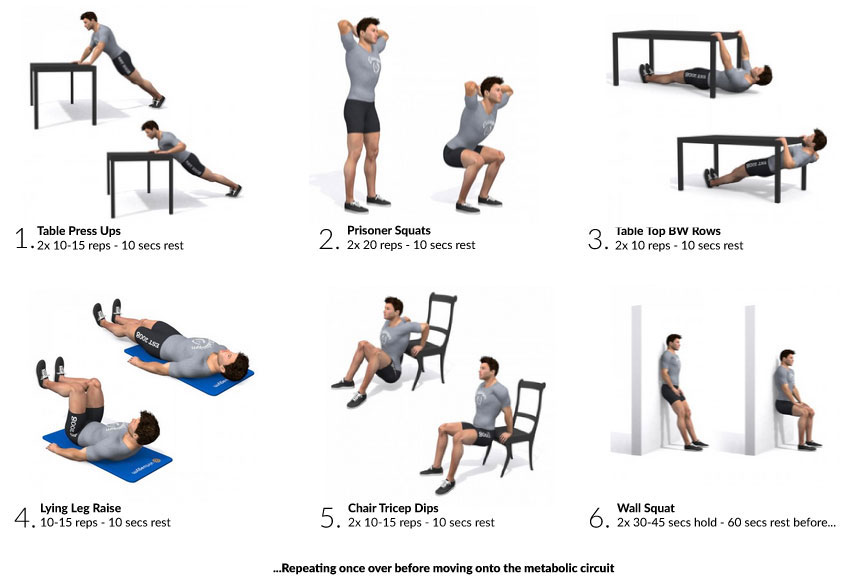
Once you've recovered and your legs have stopped shaking, let's draw this workout to a close by really cranking the intesity up as we finish off with our four-exercise metabolic circuit!
Metabolic exercises - these really get your heart rate elevated, building on cardiovascular fitness as well as helping to mobilse 'stubborn' body fat as we move onto our High Intensity Interval Training (HIIT) phase. Similar to the circuit training, these exercises have a high metabolic cost to them allowing for greater energy expenditure and an increase in the body's metabolism for several hours afterwards! HIIT has also been shown to be a time efficent way of reducing cardiovascualr disease (CVD) risk factors in adolescents [3], a condtion that's more prevelant in the sedantry population.
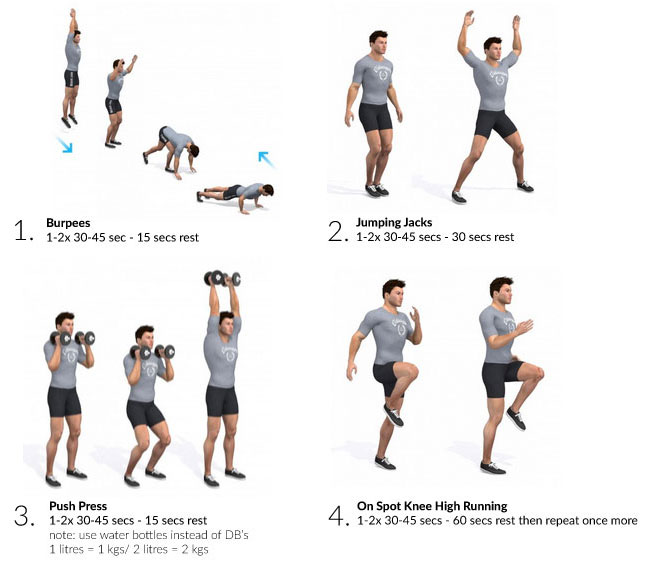
And finally, if there's time...
Core exercises - if you have both the time and the energy then why not top the workout off by strengthing the core? It's a region often left underused and weak by people sat down for most of the day. These two simple but effective exercise are a great start to building up a stronger core, which a recent study showed core "assists in the alleviation of chronic low back pain" [4].
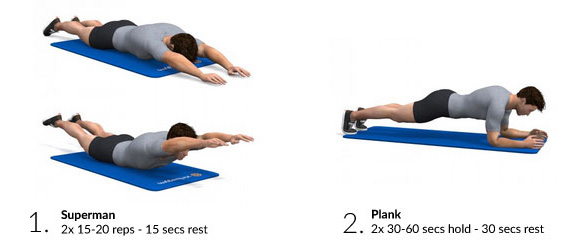
Wrapping up - the workout will take around 15-25 minutes depending on your level of fitness and how many circuits/rounds you complete. For beginners I would advise performing only one circuit of the above with the idea of progressing up to performing it twice or even three times over for more advanced people.
The number of calories you can burn depends entirely on your fitness levels, your weight, the exercises you choose to do and the intensity with which you perform them. Compared to general sitting at a desk which burns around 38Kcals per hour, our deskercise routine could get you burning around 190Kcals in half an hour; 5 times as much! [5]. However, if exercising at your desk isn't possible then try increasing your general movement, such as tapping your feet, moving your fingers and even maintaining proper posture. Research conducted on a group of twenty women found if the obese women mimicked the activity patterns of the lean women, including a modification of posture allocation, an additional 300 kcal could be expended every day, irrespective of exercise [5].
Note: It’s important to remember that although beneficial, desk exercises are not a proper substitute for a gym workout, or HIIT session. However, they will prevent decline and keep you pain free, mobile and certainly more energised at work; which is certainly a win for you, your health and the boss!
You may also find useful
Our blog post on: Back Pain. Getting to the core of the problem
Sources:
[1] Kelleher AR, Hackney KJ, Fairchild TJ, Keslacy S, Ploutz-Snyder LL. The metabolic costs of reciprocal supersets vs. traditional resistance exercise in young recreationally active adults. J Strength Cond Res. 2010 Apr;24(4):1043-51.
[2] Murphy, Emmett; Schwarzkopf, Robert. Effects of Standard Set and Circuit Weight Training on Excess Post-exercise Oxygen Consumption. Journal of Strength & Conditioning Research. 1992
[3] Buchan DS, Ollis S, Young JD, et al. (2011). "The effects of time and intensity of exercise on novel and established markers of CVD in adolescent youth". American Journal of Human Biology 23 (4): 517–26. doi:10.1002/ajhb.21166. PMID 21465614.
[4] Chang, Wen-Dien, Hung-Yu Lin, and Ping-Tung Lai. "Core strength training for patients with chronic low back pain." Journal of Physical Therapy Science 27.3 (2015): 619-622.
[5] http://calorielab.com/burned/
[6] Johannsen DL, Welk GJ, Sharp RL, Flakoll PJ. Differences in daily energy expenditure in lean and obese women: the role of posture allocation. Obesity (Silver Spring). 2008;16(1):34-9. doi: 10.1038/oby.2007.15.
About Chris Hall
As the founder of Hall Training Systems, it is my mission to provide you with the very best personal training experience. I set up Hall Training Systems as Oxford's leading personal training service in nutrition, performance and weight loss, ensuring I can deliver the very best in training techniques.
You can find me on Facebook, Google+ or why not even give us a Tweet @Hall_Training

